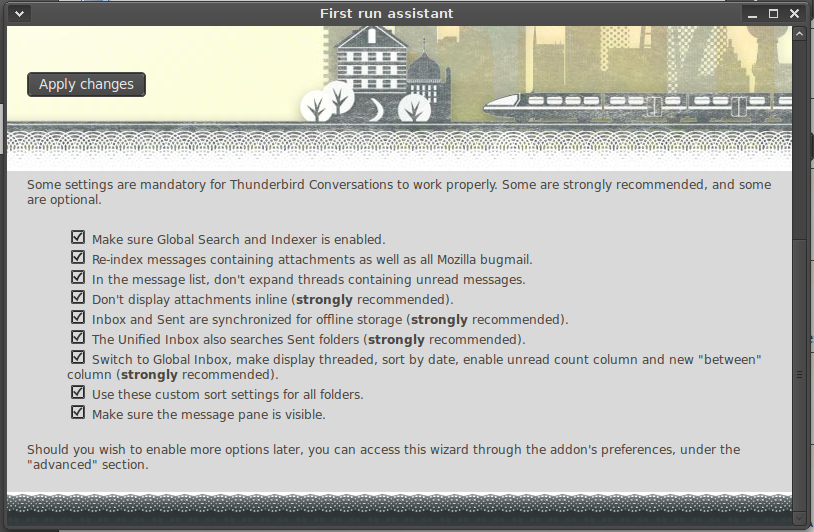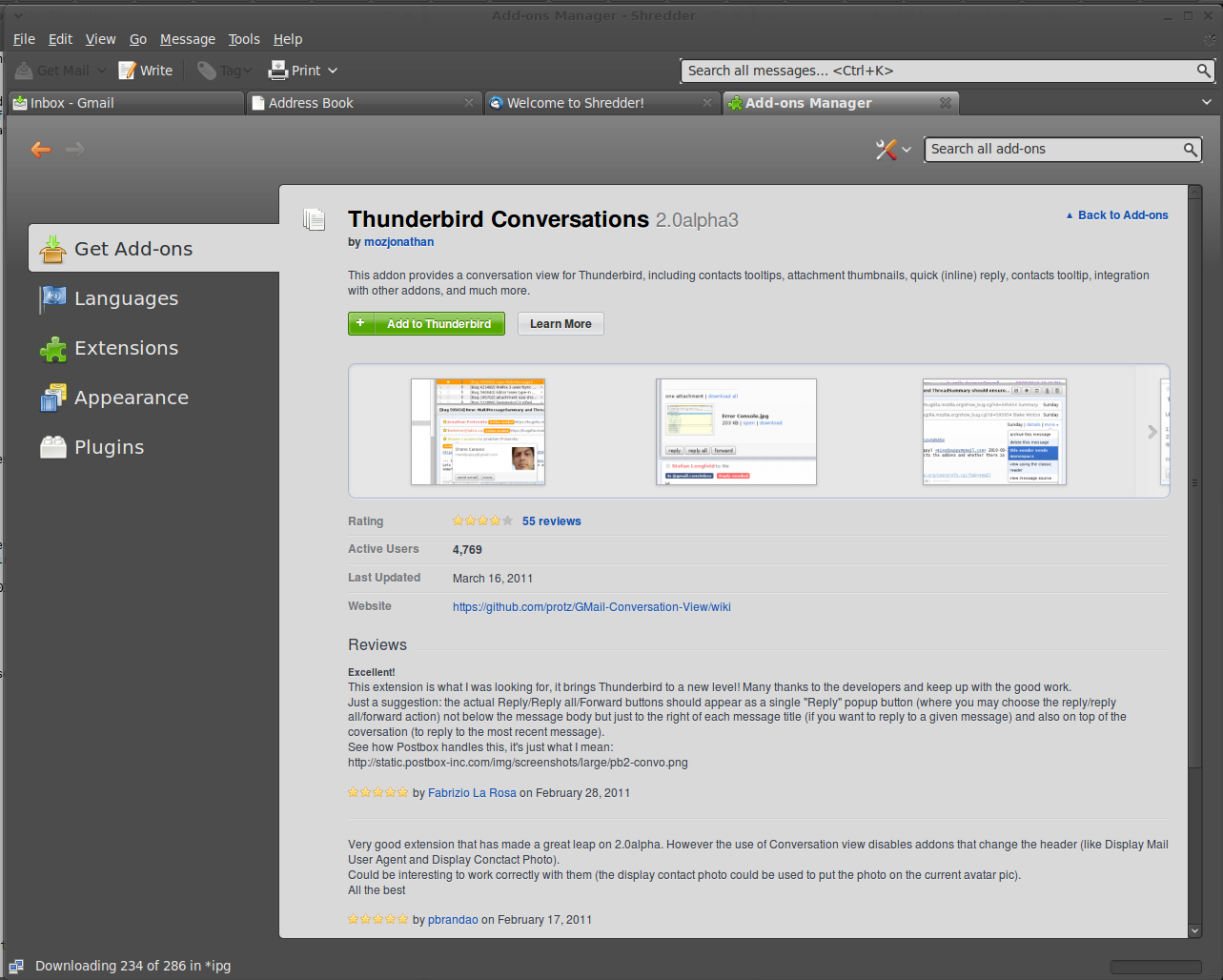Mozilla Messaging is the Mozilla Foundation’s dedicated communications division, which develops the Thunderbird email client just like Mozilla Corporation develops Firefox. And just like Firefox, a new release of Thunderbird is being polished for release. Let’s take a look at what’s new and what’s improved in Thunderbird 3.3, examining the latest testing release, 3.3 alpha 3.
For starters, as the version number indicates, 3.3 is an incremental update to the current version of Thunderbird (3.1), not a major revision like Firefox 4. For one reason or another, Mozilla Messaging feels some pressure to make periodic updates on a roughly similar schedule as Firefox (although as far as I am aware, this is not a policy decision imposed by Mozilla). That is probably good from a brand management perspective, and it ensures that we see periodic updates, but Mozilla Messaging is a much smaller organization than Mozilla Corp, and email simply doesn’t change as fast as Web technology does, so the releases tend not pack as lengthy of a feature list.
The Core
But don’t misunderstand me: Thunderbird 3.3 carries some really interesting UI improvements in 3.3, some important changes under the hood, and some intriguing new work to sample.
The most important change is in the “under the hood” category, as Thunderbird switches to the Gecko 2.0 rendering engine (the same renderer used by Firefox 4). That means Thunderbird will be able to render any content that Firefox can render, supporting modern standards like HTML 5 and CSS 3, plus substantially faster rendering for all content. I haven’t received any emails making heavy use of JavaScript since I started my test, but I have tested the Lightning calendaring extension with 3.3, and the calendar component uses both JavaScript and CSS, hitting the renderer hard. On my meager dual-core AMD box, there was a noticeable speed-up. Plus, support for newer standards opens the doorway to slicker calendar theming.
It may be a closely guarded secret, but Thunderbird can also be used as an RSS and Atom feed feeder, an evolution from its longtime support of NNTP news. This feature also benefits from the Gecko improvements, but it also gains a vital new ability: the power to load multimedia content, via plug-ins, inline, without user intervention. In retrospect, I may have heard about Thunderbird’s feed-reading capabilities in the past, but never given it a fair shake due to just such a shortcoming. I’ll be looking more closely into that in the future.
| Additional Reading |
|---|
The big interface changes keep Thunderbird in line with the evolving UI work in Firefox. Thunderbird has had tabs for a while — including tabs for search results and (optionally) for Lightning’s calendar and task views, but they have never been re-orderable. 3.3 allows you to drag-and-drop tabs into any order you like, including dragging them into empty space to open up the selected content in a new window. This is especially useful for searching your message history, when you might want to keep search results and opened messages visible simultaneously.
The add-ons manager also opens in a tab now, rather than in a separate utility window. That makes it easier to use, in large part due to the roomier layout of a full-sized app window. Like Firefox, you can search for add-ons directly within the add-ons manager and view “recommended” extensions.
The email account creation wizard has undergone a thorough revamp, fixing what was apparently regarded as a confusing process for new users. The wizard does automatically probe Mozilla’s database of common email providers to auto-select the correct settings, which will undoubtedly handle most of the common cases. The visual layout of the account settings in process has also been changed, hopefully to better reflect the connections between certain options — such as placing incoming and outgoing server settings into two horizontal rows, rather than a long vertical list of input boxes. Even if you don’t know what “port” and “SSL” mean, it’s clearer how they are connected to the mail server in the new layout.
There are also scores of tiny little UI improvements scattered around the interface — the size of attachments is now listed in the email message view, for example, there is a new troubleshooting wizard, the spell-checker is now available from the right-click context menu, and so on. The full list is available for a relaxing read-through on Bugzilla.
What Didn’t Make It (at Least Yet)
There are a few features that were originally scheduled for 3.3 that don’t appear to have made the most recent alpha. The biggest in my personal opinion is support for Mozilla’s synchronization service, Firefox Sync. The initial plan was to use the sync infrastructure to synchronize address book contacts and user preferences, perhaps even account settings and add-ons. That would make it trivial to use Thunderbird on more than computer. It looks like sync is still coming down the pipe, it just might take a while.
In case it’s not clear, there is no plan to use Thunderbird to synchronize your vast archive of email; that would essentially entail Mozilla becoming an email service provider. But interestingly enough, something along those same lines has been discussed. Apparently user testing reveals that a lot of new users expect to get an email address when they first download and install Thunderbird, so the project has looked into the possibility of offering some sort of service. There is just no announced plan for now.
 A couple of other proposed changes that didn’t make the cut include switching to SQLite for local storage, tying in to Firefox’s installed search engines to enable right-click text searches, and including support for personas — lightweight, skin-deep themes — directly within the app, rather than as a plugin. There are also plans to rework the address book code, but there is no firm plan in place for how the new UI should operate, so it looks like that is at least a release cycle away. Well, a release cycle away from the main branch. One of the other interesting twists is that you can start testing new Thunderbird features without waiting for periodic releases of the app.
A couple of other proposed changes that didn’t make the cut include switching to SQLite for local storage, tying in to Firefox’s installed search engines to enable right-click text searches, and including support for personas — lightweight, skin-deep themes — directly within the app, rather than as a plugin. There are also plans to rework the address book code, but there is no firm plan in place for how the new UI should operate, so it looks like that is at least a release cycle away. Well, a release cycle away from the main branch. One of the other interesting twists is that you can start testing new Thunderbird features without waiting for periodic releases of the app.
What Didn’t Make It — But Which You Can Still Test
Recently the Thunderbird team has started building proposed feature enhancements into extensions to test out new code before it hits the main trunk. Mozilla Messaging has put together four extensions into an officially-branded “add-on collection” that you can install if you want to help testing.
The biggest change is found in the Conversations add-on, which adds a Gmail-style conversation view to messages. This view features collapsible panes for each message in the thread, tooltip-like popups for contacts, an inline message editor to send responses, and thumbnail views of attachments. In short, it mimics the default message view of Gmail almost completely. The add-on installer includes a “conversion assistant” that makes a number of changes to you account configuration in order to facilitate the change (such as storing sent messages in the same mailbox as incoming messages), so it is not an add-on to be taken lightly, but at least the assistant warns you thoroughly before starting.
The Open Search add-on implements the Firefox-integrated search behavior mentioned earlier. This one seems like a no-brainer to me; without it, when you need to look up a term or name found in an email, you just end up copying it in Thunderbird and instigating the search in Firefox anyway.
In the same vein, Get An Account prototypes the “set up a new email account” feature also discussed earlier. It’s a bit hard to judge the usefulness of this feature at present, as the add-on only lets you set up an account with the paid email provider Hover. (People still pay for email?) What will really be newsworthy is if (or when) Mozilla begins offering its own email service. It is one of the few organizations I would trust to get security and privacy right, after all — and that might even worth paying for to some people.
Finally, Contacts is a variant of Mozilla Labs’ Contacts In The Browser experiment, which attempts to seamlessly blend personal contacts from different online services into your personal, local address book collection. I’m not quite sold on the idea because I don’t see why this functionality isn’t built directly into the address book component, but it certainly makes more sense to include it in Thunderbird than in Firefox.
You’ll also notice that I mentioned the Lightning extension earlier. For now, Thunderbird regards almost all 3.1-compatible extensions as incompatible with the 3.3 alphas (judging from the mailing list, this seems to be something that the Thunderbird developers can flip a switch on for testing purposes; marking all extensions as incompatible for the pre-release code prevents accidental data loss). Thus I was pleasantly surprised to find that the pre-release Lightning and Google Calendar Data Provider extensions arecompatible with Thunderbird 3.3, and decided to test them. Do so at your own risk if you think you might go back to 3.1, however: the add-ons UI does not make downgrading to earlier releases easy.
Message in a Bird
The final release of 3.3 won’t bring a long list of new features to Thunderbird, but it is still a must have — both for the power of the Gecko renderer inside, and the small but incremental UI improvements. Just as important is the Thunderbird team’s decision to start making UI and feature enhancements available as options via the add-ons mechanism. I think this is a pure win; at various points in years past, people have criticized the “slow pace” of development in Thunderbird. Using add-ons to incrementally develop and test features will make the release cycle seem shorter to those that want to test new features, while keeping the app stable for those folks who don’t like other people messin’ up their email.
I also have to give a big thumbs up to the Conversations extension and Open Search; these definitely make Thunderbird a more pleasant reading and writing environment. Here again, the Thunderbird team deserves credit for making new features available that come from the “web experience.” Along those same liens, the prospect of Mozilla Messaging offering its own email service in the future is intriguing — I can’t wait to see where it ends up. We’ve already seen Mozilla Messaging dip its toes into non-Thunderbird activities recently, with Mozilla Raindrop and Mozilla F1. It’s good to see a stalwart application like an email reader pushing the envelope.





